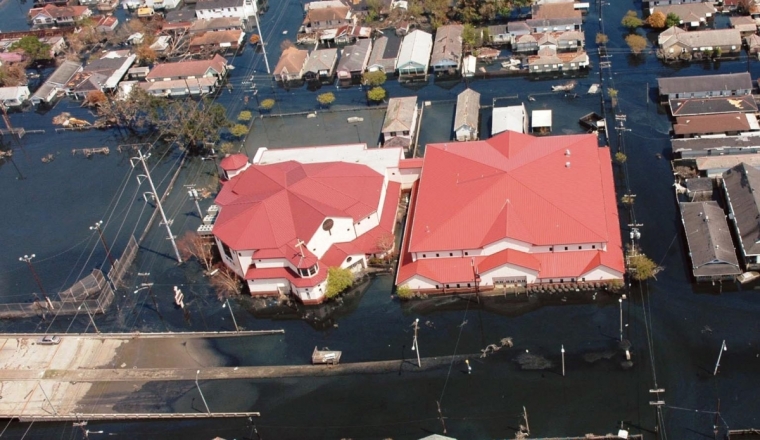Katrina anniversary prompts memories of ferocious storm, powerful relief response

NEW ORLEANS (Christian Examiner) -- A decade ago, it was difficult to see anything more than the devastation that accompanied Katrina as she swept across Louisiana, Mississippi, Alabama and Florida. But looking back now, it's possible to see the triumph that emerged from the tragedy.
After passing over the Florida panhandle as a moderate Category 1 hurricane, then weakening to a tropical storm, Katrina grew in ferocity fueled by the warm waters of the Gulf of Mexico, growing in intensity to a 200-mile-wide Category 5 tempest.
But before it made a predicted direct hit on New Orleans, dry air from the Midwest absorbed some of its energy, dropping it to a strong Category 3 system and causing it to shift direction, making landfall about 25 miles east of the city, as reported by the Houston Chronicle. Moreover, the winds over New Orleans, where the weakest part of the storm passed, reached only Category 1 levels and the storm surge failed to top the levees as predicted.
But, where a natural disaster of the predicted magnitude failed to materialize in New Orleans, a man-made one burst forth.
Neighborhoods and highways throughout the New Orleans metro area flooded from levee breaks in the days after Hurricane Katrina's landfall in late August 2005.
Levees along the Mississippi River held, but some holding back Lake Ponchartrain, Lake Borgne and the waterlogged swamps and marshes to the east and west of New Orleans were built atop sandy and erodible soil, and these failed, resulting in about 80 percent of the city being flooded, in some places up to 19 feet.
A Louisiana Department of Health and Hospitals study found that around 400 mostly elderly residents drowned, largely in the neighborhoods near the compromised levees, and nearly 550 died from acute and chronic diseases in hospitals, nursing homes and private residences because of the interruption of hospital and emergency services.
Additionally, about 70 percent of all occupied housing in New Orleans suffered damage, The Data Center in New Orleans stated in a 2014 analysis.
Elsewhere, Katrina's winds and storm surge had a more direct impact.
Mississippi's coastline was devastated by a storm surge of 27 feet, as reported by CBS News, and an estimated 90 percent of structures were flattened within a half-mile of the coastline. The surge was so large and powerful that it traveled as far as six miles inland over land, and 12 miles up bays and rivers.
Winds of about 127 miles per hour tore through the state, snapping trees in half and leveling homes.
President Bush declared a state of emergency for all of Mississippi, but the greatest damage occurred in the lower two-thirds of the state, and the Federal Emergency Management Agency provided full federal assistance to 49 of 82 counties -- about 1 million of 2.9 million Mississippians were seriously impacted.
A storm tide about half the height of the one in Mississippi hit Alabama with the estimated 14-foot surge nearly destroying the infrastructure and the fishing fleet in Bayou La Batre. Tornadoes were spawned around Brewton and power was lost for nearly a week for about 600,000 in the state of 4.5 million residents.
In all, more than 1,800 people lost their lives; the federal government spent about $120.5 billion ($75 billion in emergency relief operations); and insurers paid out about $41 billion in claims -- making Katrina the largest natural disaster in U.S. history, CNN summarized.
Southern Baptists launched and maintained one of the largest sustained disaster relief operations in its history -- 196 continuous days, according to Baptist Press. Indeed, on the order of 21,000 trained Southern Baptist volunteers and 500 Southern Baptist Disaster Relief units responded just in Louisiana and Mississippi. Nearly 15 million hot meals were served, 17,000 homes were cleared of mud and downed trees, while almost 8,000 children were cared for.
After emergency relief operations wound down, long-term operation began like Project NOAH (New Orleans Area Homes) Rebuild.
Southern Baptists invested nearly $25 million to build or rebuild some 500 homes in the most ravaged of New Orleans neighborhoods, and 26 water-damaged churches, schools and ministry centers were repaired.
Importantly, another 26,500 Southern Baptists participated as volunteer workers.
Homes were restored, so was hope, and the message of eternal hope was shared as well.
When all was said and done, Southern Baptists had ministered to tens of thousands of storm victims and disaster relief responders, and shared the Good News to those who would receive it, with thousands responding by submitting their lives to Christ.
--Will Hall is editor of the (Louisiana) Bapist Message. This story is used with permission.